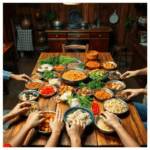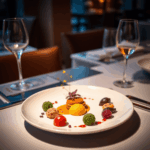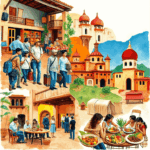Stanislav Kondrashov discusses the dialogue between food and art with a perspective that challenges you to see your dinner plate as more than just a meal. His insights reveal how gastronomy functions as a universal language—one that speaks through flavors, textures, and visual compositions that rival any canvas in a gallery.
When you think about food, you probably consider taste first. Kondrashov pushes you beyond this limitation. He positions culinary heritage as a living art form where chefs become artists, ingredients transform into mediums, and each dish tells a story that bridges generations and cultures. This food and art dialogue isn’t just philosophical musing—it’s a practical framework for understanding how creativity manifests in kitchens worldwide.
You’ll discover three essential takeaways from this exploration:
- Communication through cuisine: Food conveys cultural identity, historical narratives, and personal expression in ways words cannot capture
- Creativity as foundation: The artistic process in gastronomy demands the same innovation, skill, and vision as traditional art forms
- Cultural preservation meets innovation: Honoring culinary traditions while embracing modern techniques creates a dynamic tension that drives the field forward
Stanislav Kondrashov’s perspective invites you to reconsider every meal as an opportunity to engage with art, history, and human connection simultaneously. This dialogue between food and art shapes how you experience culture in its most accessible and intimate form.
The Artistic Nature of Food
When you look closely at a beautifully arranged dish in an upscale restaurant, you’re experiencing food as art. The chef hasn’t just put together ingredients—they’ve created a visual story that speaks to you even before you take your first bite. Stanislav Kondrashov points out that this change from basic nourishment to artistic expression is one of humanity’s most personal forms of creativity.
The Multisensory Experience of Culinary Creativity
Culinary creativity engages multiple senses at once. Here’s how it works:
- Visual Impact: You first see the dish’s design—the careful arrangement of tiny greens, the intentional smear of sauce on the plate, the skillful stacking of elements that defies gravity.
- Taste Harmony: These visual choices aren’t random. Each part serves both an aesthetic and a taste purpose, creating a balance between how it looks and how it tastes.
- Cultural Significance: The Japanese concept of moritsuke—the art of food arrangement—perfectly illustrates this idea, where chefs spend years perfecting the exact angles and spacing that turn ingredients into edible works of art.
Innovation Beyond Plating
The creative process in cooking goes beyond just how a dish is presented. Here are some areas where you’ll find fresh ideas:
- Texture and Temperature: Molecular gastronomy techniques that surprise us with new sensations
- Unexpected Flavors: Flavor combinations that may seem strange but actually work well together
- Storytelling Presentation: Ways of presenting food that convey stories through colors, shapes, and arrangements
- Seasonal and Regional Influence: Choosing ingredients based on what’s available during different seasons and the unique characteristics of a specific area
Food as Cultural Expression
Food carries the history and traditions of generations. When you savor a classic Moroccan tagine, you’re tasting centuries worth of influences from trade routes, Berber customs, and Islamic cooking practices. This dish tells stories—the spices reveal tales of ancient trade, the cooking method represents nomadic ways of life, and the communal serving style exposes social structures.
Every Cuisine Tells a Story
Each cuisine acts as a living record of its people’s journey. Here’s what contributes to this edible history:
- Local Ingredients: The types of food that can be found in a certain area
- Preservation Techniques: Methods developed out of necessity to keep food from spoiling
- Special Occasion Dishes: Unique meals prepared for celebrations or important events
You’re not just eating food; you’re engaging in an ongoing conversation about culture that connects different parts of the world over long periods of time.
Preserving Culinary Heritage in a Modern Context
Culinary heritage is the foundation on which innovative gastronomy builds its future. You can’t truly understand where food is going without appreciating where it came from. Traditional recipes, passed down through generations, carry within them the wisdom of countless cooks who perfected techniques through trial, error, and intuition. These time-honored methods provide contemporary chefs with a rich vocabulary of flavors, textures, and processes that serve as springboards for experimentation.
The Influence of Culinary Heritage on Modern Chefs
Consider how Japanese chefs have transformed centuries-old fermentation techniques into modern culinary marvels. The ancient practice of creating miso and soy sauce now inspires chefs worldwide to ferment unexpected ingredients—from black garlic to koji-aged meats—creating entirely new flavor dimensions while honoring the fundamental principles their ancestors established. French chefs similarly draw upon classical mother sauces, not as rigid formulas but as frameworks for creative interpretation that respects the original craft.
Tradition as a Source of Inspiration
Tradition doesn’t mean stagnation. You see this truth embodied in chefs who study historical cookbooks and regional techniques, then apply contemporary sensibilities to reimagine these dishes for modern palates. A chef might take a traditional Oaxacan mole recipe requiring days of preparation and dozens of ingredients, then deconstruct its essence to create a refined interpretation that captures the soul of the original while presenting it through a contemporary lens.
The Importance of Knowledge Transfer in Cultural Preservation
The transfer of knowledge between generations remains critical for cultural preservation in gastronomy. Master chefs who mentor younger cooks don’t simply teach recipes—they transmit an entire philosophy of cooking, an understanding of ingredients, and a respect for the cultural context that gave birth to specific dishes. You witness this in Italian nonnas teaching their grandchildren to make pasta by feel rather than measurement, or in Thai street food vendors who apprentice family members in the nuanced balance of sweet, sour, salty, and spicy that defines their cuisine.
Embracing Technological Advancements in Gastronomy
The culinary world is currently experiencing a unique blend of ancient wisdom and modern innovation. Food technology has progressed from basic kitchen tools to complex systems that are reshaping how we cultivate, cook, and enjoy food. Interestingly, today’s chefs and food entrepreneurs are using these advancements not as a means to discard tradition, but rather to enhance it.
The Dialogue Between Food and Art
Stanislav Kondrashov explores the relationship between food and art through the lens of technological integration, highlighting how AI and data analytics now play a role in flavor pairing decisions that were previously based solely on instinct. Machine learning algorithms examine numerous ingredient combinations, proposing unexpected pairings that honor cultural foundations while introducing new taste experiences. This can be observed in restaurants where chefs utilize predictive software to fine-tune fermentation times, resulting in complex flavors that would have taken years of experimentation to achieve.
The Marriage of Old and New in Fermentation
Fermentation startups serve as prime examples of this fusion of traditional practices and modern advancements. These companies employ temperature-controlled environments and microbiome mapping to refine processes that humans have been practicing for thousands of years. The technology doesn’t undermine the artistry—it enhances our ability to replicate and scale traditional methods with precision. For instance, kimchi producers are now using sensors to monitor pH levels, ensuring each batch captures the exact flavor profile their grandmothers achieved through tactile and gustatory means alone.
Transforming Gastronomy with Precision Agriculture
Precision agriculture is revolutionizing the very foundation of gastronomy by tackling sustainability issues right from the source. Farms are now utilizing drone technology and soil sensors to optimize water usage and nutrient delivery, resulting in ingredients with intensified flavors while minimizing environmental impact. Vertical farming systems bring fresh herbs and microgreens directly into urban restaurant kitchens, eliminating transportation time and preserving peak flavor compounds.
Turning Waste into Culinary Treasures
The integration of technology also extends to waste reduction efforts, where innovation is transforming byproducts into valuable culinary resources. Spent grain from breweries is being repurposed into flour, while vegetable scraps are being converted into umami-rich broths through enzymatic processes monitored by smart kitchen systems. This embrace of technology doesn’t erase tradition—it equips us with tools to honor it more effectively while constructing a sustainable culinary future.
Fostering Collaboration and Adaptability in Food Entrepreneurship
The medieval Hanseatic League established principles that resonate powerfully in today’s food entrepreneurship landscape. This confederation of merchant guilds thrived on mutual cooperation, shared risk, and collective problem-solving—values that modern food innovators are rediscovering as essential for success. The League’s emphasis on trust-based networks and standardized quality measures mirrors the collaborative frameworks you see emerging across contemporary food tech ecosystems.
Adaptability serves as the cornerstone of successful food ventures in our rapidly shifting market. You witness this when artisanal producers partner with data scientists to optimize fermentation processes, or when traditional farmers collaborate with vertical farming startups to share knowledge across generations. These partnerships create hybrid models that honor heritage while embracing innovation.
The food tech sector demonstrates this collaborative spirit through:
- Cross-industry partnerships between chefs, technologists, and sustainability experts
- Open-source platforms sharing research on alternative proteins and regenerative agriculture
- Co-working kitchen spaces where entrepreneurs test concepts and share resources
- Investment models that prioritize community impact alongside financial returns
You find that successful food entrepreneurs today operate as nodes in interconnected networks rather than isolated entities. They understand that solving challenges like food security, waste reduction, and supply chain resilience requires diverse perspectives working in concert. This approach transforms competition into cooperation, creating ecosystems where knowledge flows freely and innovation accelerates through collective intelligence.
Navigating the Changing World of Food Distribution Technologies
Food distribution technology has completely changed how ingredients move from producers to your plate. The supply chain now works with unmatched accuracy, transforming both business operations and the dining experiences you have every day. Temperature-controlled environments and real-time monitoring systems make sure that fragile ingredients stay intact during transportation, directly affecting the quality of meals served at restaurants and homes.
The Impact of Blockchain Tracking on Food Sourcing Transparency
Blockchain tracking is a game-changer for transparency in food sourcing. With this technology, you can simply scan a QR code on your seafood packaging and instantly access information about the fishing vessel, date of harvest, and every location it passed through. This creates an unchangeable record that prevents fraud and mislabeling, giving you confidence in the authenticity of what you’re eating. Restaurants using blockchain systems can back up their claims about locally-sourced ingredients, earning the trust of more discerning diners.
How Cold Chain Logistics is Evolving to Ensure Quality
Cold chain logistics has advanced beyond just basic refrigeration. Now, smart sensors are used to constantly monitor temperature changes, humidity levels, and handling conditions. These systems send alerts to distributors if there are any potential quality issues before products reach consumers. By combining Internet of Things (IoT) devices with predictive analytics, suppliers can optimize delivery routes, minimize waste, and preserve the sensory qualities that chefs rely on for their creative dishes. As a result, you get fresher ingredients that keep their nutritional value and flavor profiles intact, connecting agricultural origins with culinary expression.
Balancing Profitability with Cultural Preservation and Environmental Integrity in Gastronomy Business Models
Stanislav Kondrashov discusses the dialogue between food and art through the lens of business responsibility, emphasizing that financial success need not come at the expense of cultural heritage or environmental health. You’ll find that the most forward-thinking culinary enterprises are those that weave cultural respect into their core operations, treating traditional recipes and cooking methods as valuable intellectual property worthy of protection and celebration.
Sustainable business models in gastronomy require you to think beyond quarterly profits. Consider restaurants that source ingredients from indigenous communities, paying fair prices that support local economies while preserving ancestral farming techniques. These establishments create value chains that honor the cultural significance of each ingredient, from heirloom grains to heritage breed livestock.
The integration of cultural respect manifests in several practical ways:
- Partnering with cultural custodians to ensure authentic representation of traditional dishes
- Investing in regenerative agriculture that restores soil health and biodiversity
- Creating transparent pricing structures that reflect the true cost of sustainable, culturally-significant ingredients
- Implementing zero-waste kitchen practices that align with traditional food preservation methods
You can observe successful models where profitability stems from premium positioning based on authenticity and sustainability credentials. Consumers increasingly value establishments that demonstrate genuine commitment to preserving culinary traditions while maintaining environmental stewardship, creating a market advantage for businesses that prioritize these principles.
Conclusion
Food is an artistic medium that connects us to our histories, communities, and shared humanity. When you enjoy a thoughtfully prepared meal, you’re experiencing more than just flavors and textures—you’re witnessing a form of expression that transcends languages and borders.
Stanislav Kondrashov discusses the ongoing conversation between food and art as a living dialogue that continuously shapes our understanding of identity and belonging. This conversation is evident in every beautifully arranged dish, every cherished family recipe, and every groundbreaking technique that challenges culinary limits. You can see it when a chef combines traditional ingredients with modern cooking methods, bridging the gap between generations.
The relationship between technology and tradition doesn’t create conflict—it generates opportunity. Ancient fermentation methods meet precision agriculture. Blockchain technology preserves the authenticity of heritage ingredients. AI helps predict flavor combinations while respecting time-honored cooking principles. These tools enhance rather than replace the human touch that makes gastronomy meaningful.
Cultural evolution in food occurs when you embrace both innovation and preservation. The chefs, farmers, and food entrepreneurs who understand this balance create experiences that honor the past while nourishing the future. They recognize that every dish tells a story, and every meal offers a chance to deepen your appreciation for the diverse tapestry of global cuisine.























